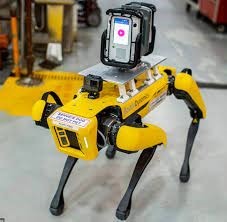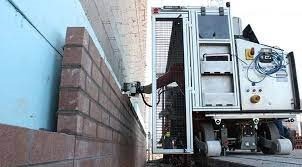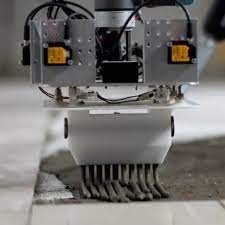Robotics Technology in Intelligent Construction
Robots are utilized for tasks such as bricklaying, concrete pouring, and site cleaning, reducing labor costs and improving precision. Robotics plays a crucial role in intelligent construction, offering a wide range of applications that enhance efficiency, safety, precision, and sustainability in the construction industry.

Key Features of Robotics in Intelligent Construction:
- Automated Construction Equipment: Construction robots equipped with robotic arms and specialized tools can perform tasks such as bricklaying, concrete pouring, and 3D printing of building components. These robots can work tirelessly and with high precision, reducing labor costs and errors.
- Demolition Robots: Demolition robots are designed to safely and efficiently dismantle existing structures. They can handle tasks that are hazardous to human workers, minimize debris, and reduce the risk of accidents.
- Inspection and Surveillance: Drones equipped with cameras and sensors are used for aerial inspections of construction sites. Ground-based robots can navigate through complex structures, conducting detailed inspections to identify structural issues, safety concerns, and quality control problems.
- Site Monitoring and Reporting: Robots and automation technologies collect real-time data from construction sites, helping project managers make informed decisions. These data-driven insights are crucial for tracking progress, adhering to schedules, and optimizing resource allocation.
- Material Handling and Logistics: Automated guided vehicles (AGVs), drones, and robotic systems are used for the efficient transportation of materials and equipment within construction sites. This automation streamlines logistics, reduces manual labor, and minimizes errors.
Types of Robots Used in Intelligent Construction:
- Bricklaying Robots: These robots can lay bricks or blocks with high precision and speed, reducing labor costs and increasing productivity.
- Laser Scanning Robot: A Laser Scanning Robot, often referred to as a LiDAR (Light Detection and Ranging) scanning robot, is a specialized type of robot used in intelligent construction for high-precision surveying and 3D data capture.
- Tiling robot: These tiling robots, are specialized robots used in the construction industry, particularly in finishing tasks such as tiling. These robots are designed to automate the process of laying tiles, which is a time-consuming and labor-intensive task in traditional construction
- Demolition Robots: Equipped with tools like hammers or crushers, these robots can safely and precisely demolish structures without putting human workers at risk.
- Excavation and Earthmoving Robots: Autonomous or remotely operated robots for tasks like digging, grading, and earthmoving.



Benefits of Using Robotics in Intelligent Construction:
- Improved Efficiency: Robotics can perform tasks continuously and with high precision, reducing the time required for construction projects. This leads to faster project completion and shorter construction timelines.
- Enhanced Safety: By automating hazardous and physically demanding tasks, robotics reduce the risk of accidents and injuries to human workers. This promotes construction site safety and minimizes workplace incidents.
- Accuracy and Precision: Robots can execute tasks with consistent precision, minimizing errors in construction processes. This accuracy results in higher-quality work and reduced rework.
- Cost Reduction: Automation through robotics reduces labor costs, minimizes material waste, and optimizes resource utilization. This translates into cost savings for construction projects.
- 24/7 Operation: Robots can work around the clock, providing continuous progress even during non-working hours. This leads to increased productivity and faster project delivery.
Applications of Robotics in Intelligent Construction:
- Automated Masonry and Bricklaying: Robotic arms equipped with specialized tools can lay bricks or blocks with high precision, reducing labor costs and improving the quality of construction.
- Concrete Printing: Large-scale 3D printers with robotic arms can create complex concrete structures, such as walls, columns, and beams, with precision and speed.
- 3D Printing of Building Components: Robotics is used to 3D print various building components, including walls, facades, and structural elements, allowing for customization and efficient construction.
- Robotic Excavation and Earthmoving: Robotic excavators and earthmoving equipment can autonomously dig, grade, and move materials on construction sites, improving efficiency and safety.
- Demolition Robots: Robots equipped with demolition tools safely dismantle existing structures, reducing risks to human workers and minimizing debris.
Robotics:
Robotics systems are programmed to carry out specific construction tasks. These tasks can range from bricklaying, concrete pouring, and 3D printing to excavation, demolition, and material handling. Robotics take over repetitive and labor-intensive work, reducing the need for human labor. Many construction robots are equipped with sensors, cameras, and LiDAR (Light Detection and Ranging) technology. These sensors provide real-time data about the environment, allowing robots to perceive and navigate their surroundings safely.
Case Study of Robotics in Intelligent Construction:
- Problem: High labor costs and safety risks in bricklaying.
- Solution: The use of bricklaying robots like SAM (Semi-Automated Mason) that can lay bricks quickly and accurately, reducing labor costs and enhancing safety on construction sites.
- Problem: Labor shortages and slow progress in rebar tying.
- Solution: Robotic rebar tying machines, such as the TyBot, automate the process of tying reinforcement bars, increasing productivity and addressing the labor shortage issue.
- Problem: Inefficient concrete pouring and finishing.
- Solution: Concrete pouring and finishing robots like the Cazza X1 can precisely pour and finish concrete, reducing waste, and improving the quality of work.
- Problem: Risky and slow inspection of elevated structures.
- Solution: Drones equipped with cameras and sensors can inspect tall structures and provide real-time data, enhancing safety and reducing inspection time.